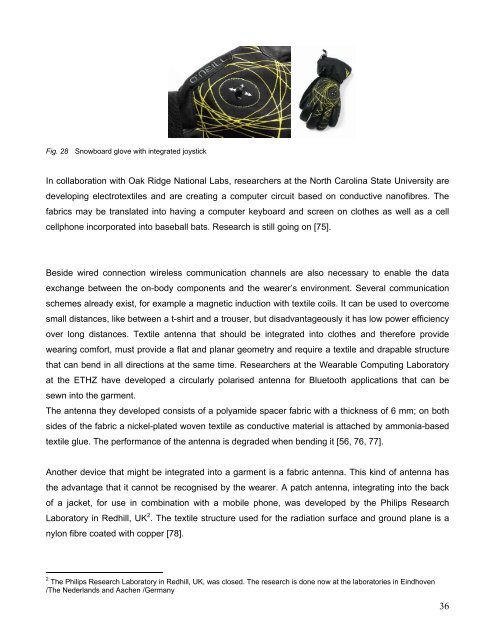Clevertex - Grado Zero Espace Srl
Clevertex - Grado Zero Espace Srl
Clevertex - Grado Zero Espace Srl
Create successful ePaper yourself
Turn your PDF publications into a flip-book with our unique Google optimized e-Paper software.
Fig. 28 Snowboard glove with integrated joystick<br />
In collaboration with Oak Ridge National Labs, researchers at the North Carolina State University are<br />
developing electrotextiles and are creating a computer circuit based on conductive nanofibres. The<br />
fabrics may be translated into having a computer keyboard and screen on clothes as well as a cell<br />
cellphone incorporated into baseball bats. Research is still going on [75].<br />
Beside wired connection wireless communication channels are also necessary to enable the data<br />
exchange between the on-body components and the wearer’s environment. Several communication<br />
schemes already exist, for example a magnetic induction with textile coils. It can be used to overcome<br />
small distances, like between a t-shirt and a trouser, but disadvantageously it has low power efficiency<br />
over long distances. Textile antenna that should be integrated into clothes and therefore provide<br />
wearing comfort, must provide a flat and planar geometry and require a textile and drapable structure<br />
that can bend in all directions at the same time. Researchers at the Wearable Computing Laboratory<br />
at the ETHZ have developed a circularly polarised antenna for Bluetooth applications that can be<br />
sewn into the garment.<br />
The antenna they developed consists of a polyamide spacer fabric with a thickness of 6 mm; on both<br />
sides of the fabric a nickel-plated woven textile as conductive material is attached by ammonia-based<br />
textile glue. The performance of the antenna is degraded when bending it [56, 76, 77].<br />
Another device that might be integrated into a garment is a fabric antenna. This kind of antenna has<br />
the advantage that it cannot be recognised by the wearer. A patch antenna, integrating into the back<br />
of a jacket, for use in combination with a mobile phone, was developed by the Philips Research<br />
Laboratory in Redhill, UK 2 . The textile structure used for the radiation surface and ground plane is a<br />
nylon fibre coated with copper [78].<br />
2<br />
The Philips Research Laboratory in Redhill, UK, was closed. The research is done now at the laboratories in Eindhoven<br />
/The Nederlands and Aachen /Germany<br />
36

















